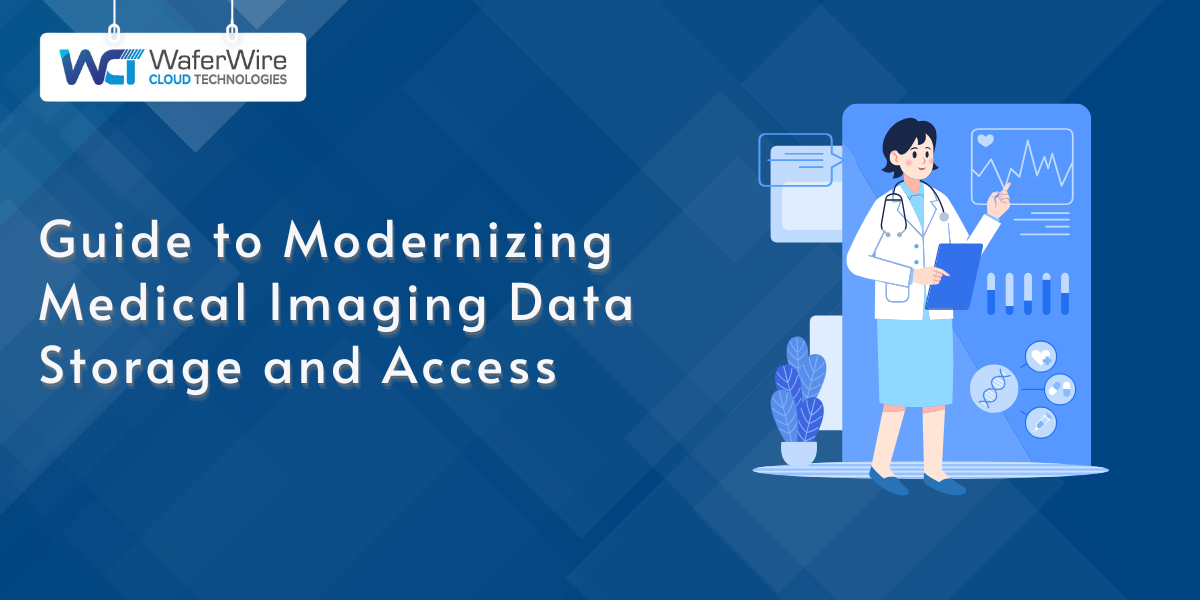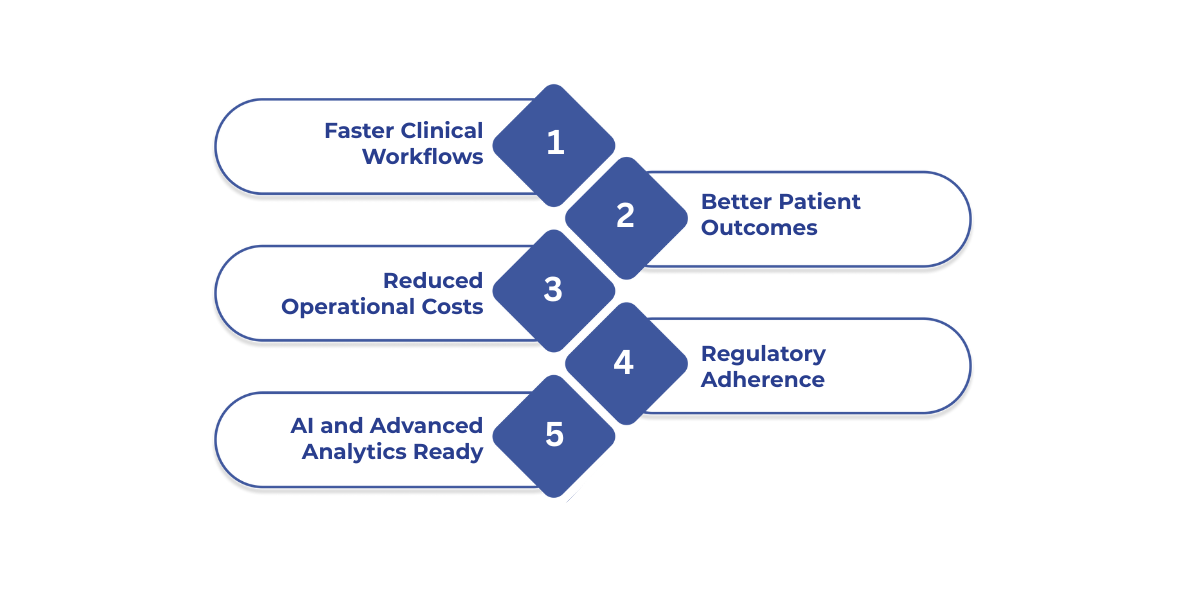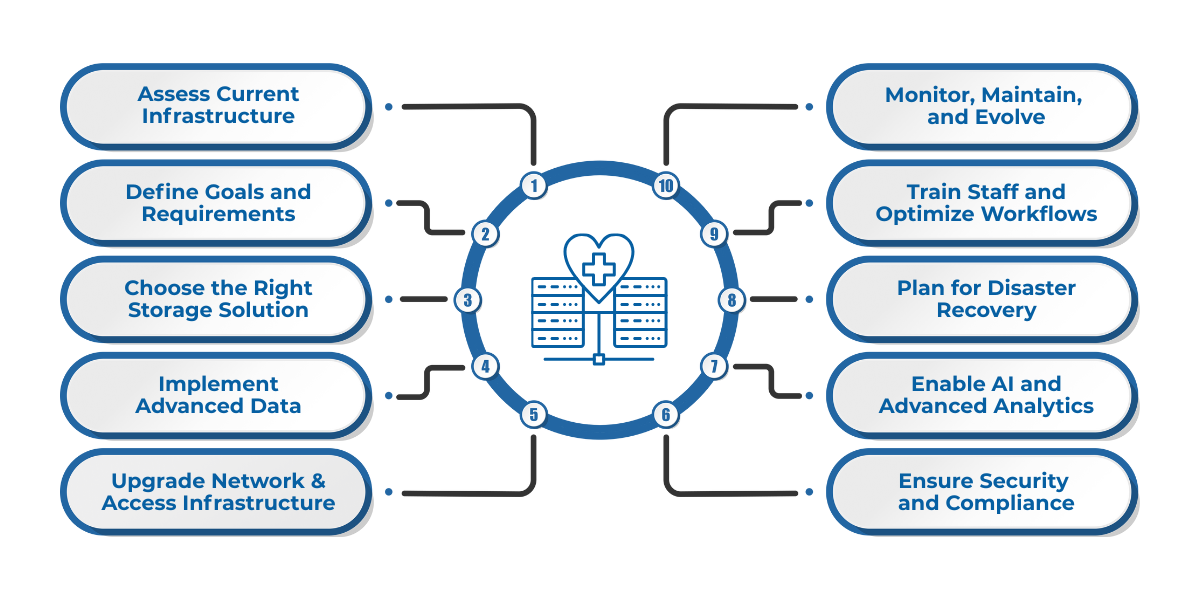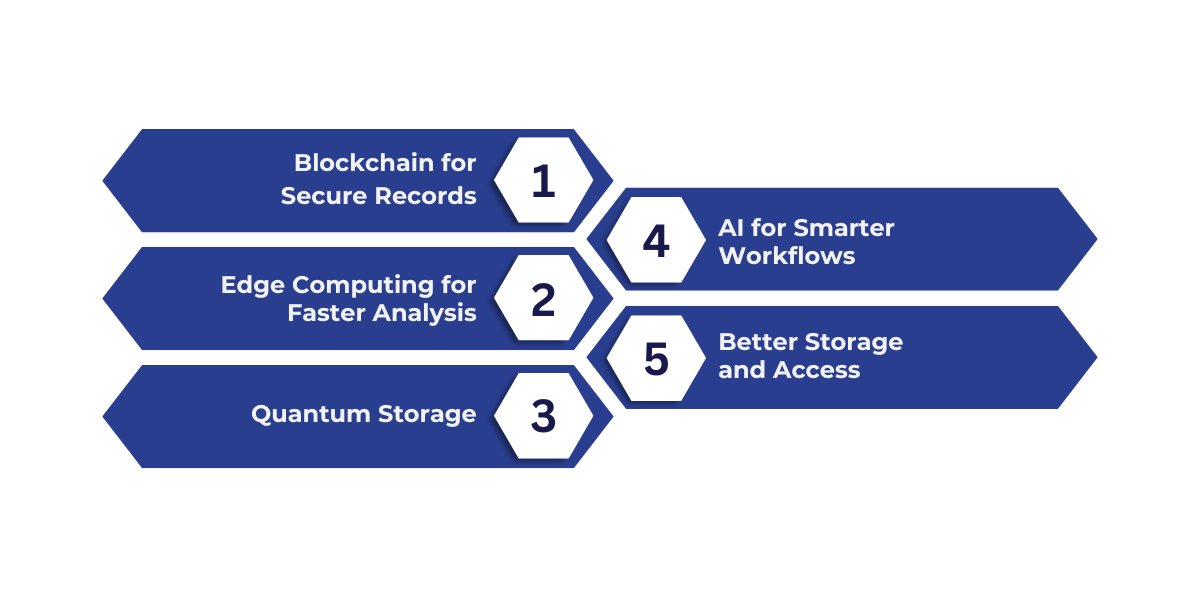

Modernizing your medical imaging infrastructure is more than upgrading storage, it’s about building a secure, scalable, and streamlined ecosystem that turns complex data into actionable insights.
In this guide, we break down the step-by-step process to modernize imaging storage and access, explore the right technologies, and highlight how these improvements lead to faster decisions, better patient outcomes, and future-ready healthcare operations.
Before you begin the modernization journey, it’s important to understand what medical imaging data is and why it matters.

Medical imaging data refers to the digital files generated from imaging technologies such as X-rays, MRIs, CT scans, and ultrasounds. This data provides critical insights into a patient’s health, helping clinicians diagnose conditions, monitor progress, and plan treatments accurately.
Here are the key advantages of modernizing medical imaging storage and access:
Example: Consider a multi-department hospital producing large volumes of imaging data every day. A modernized system allows radiologists to retrieve scans instantly, AI algorithms to process and analyze images in real-time, and administrators to maintain compliance, all without slowing clinical operations.
Also Read: How can you achieve healthcare data security?
Now that we’ve seen the importance and benefits, the next step is to explore how modernization actually works in practice.

To begin, updating medical imaging data storage and access empowers healthcare organizations to handle increasing volumes of imaging data more effectively.
By centralizing data, accelerating retrieval, and deploying scalable storage solutions, hospitals and clinics can improve operational efficiency, achieve faster diagnoses, smoother workflows, and better patient outcomes.
The following steps provide a clear roadmap to modernize your imaging infrastructure effectively.
Before introducing new systems, it’s crucial to understand your existing setup. A detailed assessment provides insight into strengths, weaknesses, and potential areas for improvement. This understanding lays the foundation for all subsequent modernization steps.
Key actions to consider include:
Once you have a clear picture of your current infrastructure, the next step is to define your objectives. Setting clear goals ensures that every investment aligns with operational priorities and long-term needs.
Consider the following factors:
Also Read: Data Integration from Multiple Sources: Steps and Tips
Selecting the appropriate storage platform is critical for balancing speed, cost, and accessibility. Understanding the options available will help you make a solution that meets both current and future needs.
Options to evaluate include:
Integration of Modern platforms like Microsoft Fabric provide a unified environment for medical imaging data, offering scalable storage, high-speed access, and seamless integration across systems.
Once storage is in place, the focus shifts to managing data efficiently. Smart management improves retrieval times, reduces costs, and prepares the system for future expansion.
Effective strategies include:
Even the best storage system requires a robust network to function efficiently. Improving connectivity ensures clinicians and staff can access imaging data quickly and securely.
Key areas to focus on:
Data security must be a core part of your modernization strategy. Protecting patient data and meeting regulatory requirements are non-negotiable.
Best practices include:
Modern imaging systems can do more than store data, they can provide actionable insights that enhance clinical decision-making even through AI integration.
Steps to implement include:
Facing delays and inefficiencies with traditional imaging systems? WaferWire enables healthcare providers to upgrade medical imaging storage and access, delivering secure, scalable, and simplified solutions that support faster workflows and better patient outcomes.
Preparing for unexpected failures ensures patient care continuity and prevents critical data loss.
Essential measures include:
Even the most advanced systems require skilled users to achieve their full potential. Training and workflow optimization enhance adoption and efficiency.
Focus areas include:
Also Read: Personalize healthcare with medical image annotation
Modernization is an ongoing process. Continuous monitoring, maintenance, and upgrades ensure your imaging system remains efficient and ready for future demands.
Key practices include:
Before implementing modernization initiatives, it’s essential to anticipate potential hurdles and understand practical ways to overcome them. Let’s explore it next.
Healthcare organizations often face obstacles like legacy systems, fragmented workflows, and regulatory pressures when modernizing medical imaging storage and access. Successfully addressing these challenges requires strategic planning and adherence to best practices.
The following table highlights common challenges and recommended best practices:
By proactively addressing these challenges, healthcare organizations can ensure modernization efforts improve workflow efficiency, safeguard sensitive patient data, and support AI-driven analytics.
Also Read: Healthcare Data Compliance with Microsoft Fabric
Once challenges are managed, the focus shifts to where medical imaging is headed.

Some key trends include:
These advancements will make medical imaging storage smarter, faster, and ready for the future of healthcare.
WaferWire helps healthcare organizations effectively modernize and optimize medical imaging data storage and access with the following services:
We provide strategic guidance to healthcare organizations, helping design and implement solutions that modernize medical imaging data storage while ensuring compliance, scalability, and operational efficiency.
We help migrate existing imaging systems to modern platforms, including Microsoft Fabric, ensuring minimal disruption, accurate transfer of large datasets, and continuous access during the transition.
We configure and customize Microsoft Healthcare solutions for medical imaging data, delivering end-to-end deployment that aligns with your operational and clinical workflows.
Using FHIRbridge® and other tools, we consolidate imaging data from multiple sources, maintain data integrity, and enable secure, real-time access while adhering to healthcare regulations.
We provide hands-on training for staff and administrators, ensuring your team can fully utilize modernized imaging systems for workflow efficiency, analytics, and patient care.
WaferWire simplifies the adoption of modern medical imaging solutions, helping healthcare organizations achieve secure, scalable, and accessible data management for better patient outcomes and operational efficiency.
Modernizing medical imaging data storage and access improves workflow efficiency, reduces operational bottlenecks, and enhances patient care. By consolidating data and using secure, scalable platforms, healthcare organizations can make faster and more informed clinical and administrative decisions.
However, implementing modern imaging solutions is just the first step. Ongoing optimization, system updates, and staff training are essential to fully realize the benefits of a modernized imaging infrastructure.
At WaferWire, we help healthcare organizations implement, optimize, and customize medical imaging solutions. From strategy and data migration to system integration and staff training, we ensure your imaging data infrastructure delivers maximum value.
Contact us today to modernize your imaging data and improve patient care.
1. How does modernizing medical imaging data improve healthcare operations?
Modernizing medical imaging data centralizes storage, streamlines access, and integrates advanced analytics, helping healthcare organizations enhance workflow efficiency, reduce errors, and improve patient care.
2. Is modern medical imaging storage suitable for facilities without large IT teams?
Yes, modern solutions offer user-friendly interfaces, low-code tools, and cloud-based management, making them accessible to facilities with limited IT resources.
3. How does AI and predictive analytics benefit medical imaging data management?
AI and predictive analytics enable faster image processing, automated anomaly detection, and improved data-driven decision-making, allowing clinicians to respond proactively to patient needs.
4. Can modernized medical imaging storage integrate with existing hospital systems?
Yes, solutions can integrate seamlessly with EHR, PACS, and other clinical systems, consolidating medical imaging data into a unified platform for better accessibility and care coordination.
5. What kind of ongoing support is available for modernized medical imaging data systems?
Providers offer continuous support, including training, software updates, troubleshooting, and compliance monitoring, ensuring healthcare organizations can maximize the value of their modernized imaging infrastructure.

